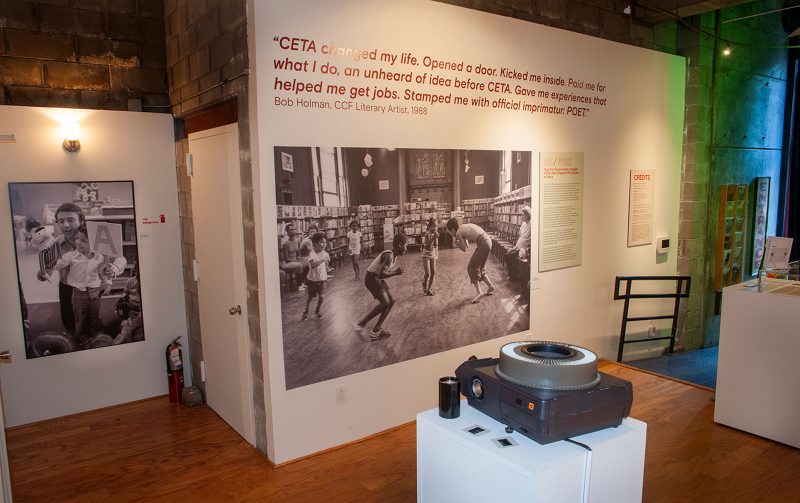
Virginia Maksymowicz and Blaise Tobia, artists and teachers living in Philadelphia, and also good friends of mine, have been working with a small number of colleagues for five years on a project to record the impact on the arts made by a federal program, the Comprehensive Employment and Training Act (1973 – 1981) – known as CETA. Maksymowicz and Tobia were two of nearly 20,000 literary, performing and visual artists and culture workers who found full-time employment through the federal program. This was the largest federal support for artists since the Works Progress Administration (WPA) in the 1930s, which notably commissioned murals in Post Offices and other federal buildings across the country. Yet, as crucial as CETA was to the ecology of the art community during the 1970s, it has been left out of all the historical accounts.
Two NYC exhibitions about CETA were held recently on the Lower East Side. One was at City Lore Gallery, which sponsored both exhibitions along with Artists Alliance, Inc.; the other was at Cuchifritos Gallery + Project Space. The City Lore exhibition emphasized visual documentation, giving a very lively and engaging picture of what artists contributed to city life at the street level. The Cuchifritos exhibition covered back-of-the-house operations: written documentation in the form of correspondence, proposals, reports and press coverage. It was fascinating for anyone with experience in arts administration, and provided a good picture of the demands of such jobs. The exhibitions were organized by Molly Garfinkel and Jodi Waynberg.
CETA was not established as an arts program. It was a jobs program, undertaken by the Department of Labor during a period of high unemployment. The Nixon administration emphasized decentralized government, so while federal funds supported the program, it made block grants to state and local governments who administered the funding. While the majority of CETA funding provided job training for low-skilled workers, it included a category for hiring “skilled unemployed” to conduct public service work, the category under which artists were employed.

Few of the artists were commissioned to produce public artworks. Rather they brought art into communities through social service programs and various non-profit organizations. They conducted classes, workshops, demonstrations and consultancies and organized performances, exhibitions and festivals. They also worked directly for a variety of arts organizations. The New York program, CETA’s largest in the arts, also acted as a booking agency; non-profits could contact them when they wanted someone to speak, teach, perform or give one-off presentations. I remember using CETA to find a novelist to read to a group of senior citizens in a community arts center in Rockland County, New York; our cost was only his bus fare.
The national success of CETA within the arts community was built upon the knowledge and professional dedication of John Kreidler, at the time an intern at the San Francisco Art Commission. Kreidler had experience with the Department of Labor and had written a master’s paper on the WPA. He understood that art was work, and substantial numbers of artists were unemployed, so they fell within the federal guidelines. Through his initiative and support from the S.F. Department of Manpower, more than 800 Bay Area artists found jobs supported by CETA between 1974 and 1981. Kreidler recognized that the San Francisco program could be use as a model for other arts communities, so he created a report to spread the word.
CETA’s impact on the arts was varied. It not only provided a living wage to a large number of artists, but it introduced neglected communities to art; it was notably multicultural long before that term was in common use; and it enabled a range of arts organizations, large and small, to survive during a very difficult financial period. In a panel that Maksymowicz organized last Spring, Senga Nengudi and Maren Hassinger, both supported by CETA in Los Angeles, spoke of the validation the program offered to young artists as well as the community of artists it encouraged.
In the Philadelphia area institutions from the Philadelphia Museum of Art to the public schools drew upon CETA funding to hire artists. The Brandywine Workshop and Archives employed 72 artists, 38 of them full time, and the Painted Bride Art Center hired its first professional staff to handle administration, theater management, maintenance, fund-raising and promotion. These are only small indications of CETA’s lasting imprint on Philadelphia’s and the nation’s arts community; CETA’s success should be acknowledged in current and future discussions of the possibilities of responsible public funding in an important social and economic sector.









